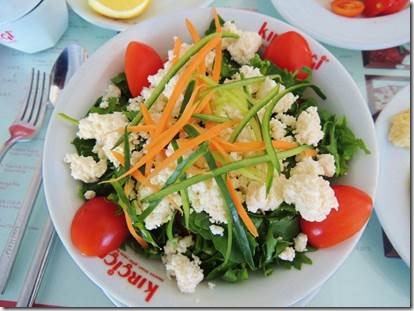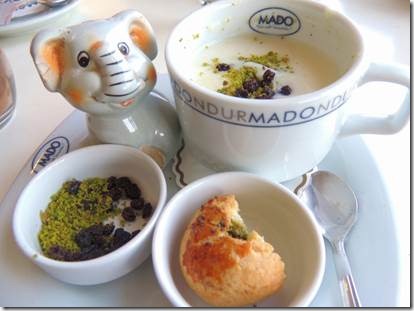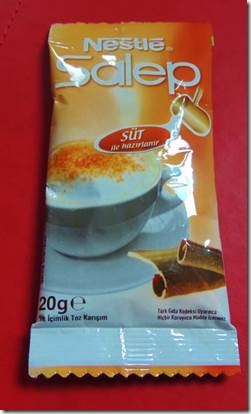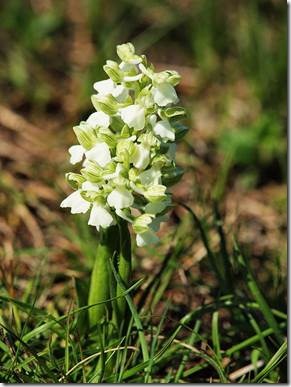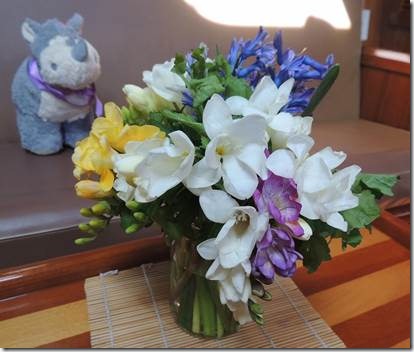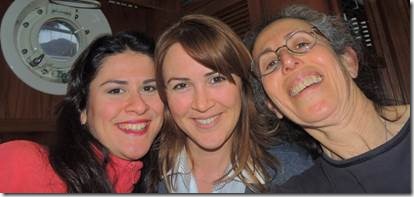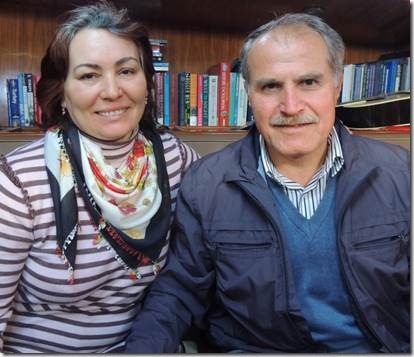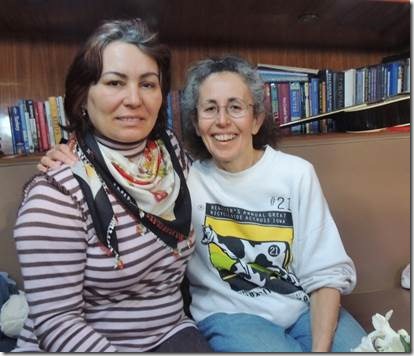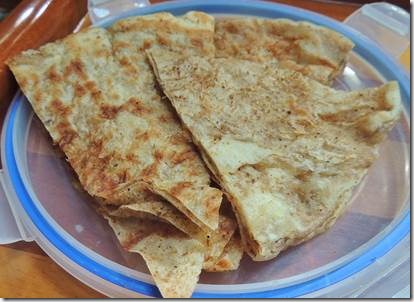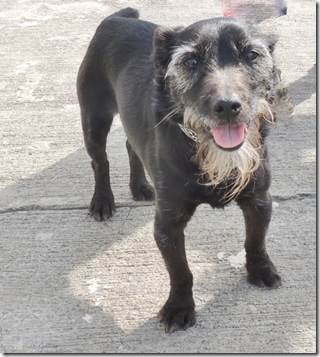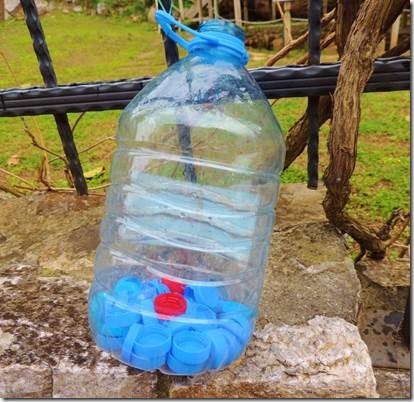Merhaba,
Randal arrived safe and sound yesterday about 10PM. He was up early this morning finally crashing out about 5:30 this evening. Rhino Randal and I are happy to see him home. As for this particular email, the food I ate was necessary for the story, but not the most interesting part. How the food came to be and the culture surrounding it is really the star of the show.
Ru
|
Feta Cheese Salad at Kırçiçeği http://www.kircicegi.com.tr/en/index_en.htm Ordinarily I’m not a feta cheese fan, but this was really good, not overwhelmingly salty at all. Just a really rich taste reminding you that cheese comes from milk. And the salad contained lots of arugula, the nutty/peppery leaf called roka here in Turkey . A great deal of “white cheese” is eaten here for breakfast: I know I ate a ton when we traveled through Turkey on our motorbike. It’s great on bread with strawberry jam. I never would have thought of it as feta. I always call it “white cheese” and ask for the kind with less salt. “White cheese, commonly known as Feta cheese in the West, is mainly produced in the Marmara (Area around Istanbul) Region, is consumed in abundance. It can be produced out of sheep or cow milk, but the production techniques may change according to region. White cheese needs 90 days to mature in salt water. High fat content white cheese is soft and smooth whereas low fat versions are harder. It is an essential part of Turkish breakfast and used in börek.” http://www.turkishculture.org/culinary-arts/cheeses-312.htm While in North Cyprus I read about Turkish Hellim cheese vs. Greek Halloumi and the cultural clashes over who really created this particular cheese with the rights to call it by a specific name. Apparently there are Feta cheese wars also. The following information comes from students in a history course at Cornell University. Part of their study of inter-European history was the study of some foods associated with different countries. “The Feta Cheese Dispute Issues of Regional Identification Involving EU Regulations and “National” Brands of Food by Mike Peluso, 11/20/2005 Introduction There has been an encouraging degree of cooperation in recent years among European countries, and it appears that the EU has helped to create a more defined sense of a truly "European" identity. The spread of ideas and culture has become more apparent than ever before. However, despite the recent successes of the EU, it has not gone without controversy. Specifically, a number of conflicts over food have emerged in the past few years. Despite the increase in cooperation, it has become apparent that there are still strong regional and national identity issues among many Europeans. In some cases, these national disagreements have extended to different types of food and the question of which culture they belong to. Feta cheese is one prime example, and it has been battled over by Greece, Denmark, and Germany, among others. The long-running disagreement over this cheese shows that cultural and economic concerns are still extremely divisive elements within the EU. Feta cheese. Feta cheese is a brined cheese that is made from goat and sheep milk. It is unclear exactly when it began to be produced in Greece, but it is discussed in several ancient Greek sources. For example, the Cyclops in Homer’s The Odyssey prepares a cheese from sheep’s milk that is believed to be feta [4]. Within Greece, feta has been produced in much the same way for thousands of years. The unique climate of the Greek mountains is believed to give feta cheese its distinct taste, with the main ingredient coming from sheep and goats that graze in the area. Greek producers have strict regulations regarding feta, including the stipulation that at least 70% of the product be made of sheep’s milk. The remainder can be made of goat’s milk, due to the difficulty in obtaining large quantities of sheep’s milk. It takes about an hour for the milk to coagulate, and then it is cut into large cubes. These cubes are packed away into barrels and refrigerated for about two months [5]. The interesting thing about feta cheese is that it continues to develop as it ages, much like fine wine. It will taste differently depending on how many months it has been allowed to age. The Greeks have been regulating this process since 1935, and their firm tradition ensures a cheese with a strong, salty taste. Other producers, like France and Denmark, often use cow’s milk in the process, and they may use coloring agents that Greek producers strictly prohibit ].” https://courses.cit.cornell.edu/his452/fetawars.html#history |
|
Selap at MADO |
|
Salep, a beverage from wild orchid. My order of salep took a while to come; longer than Mary’s coffee, but it was worth the wait. You sprinkle the chopped pistachio nuts and tiny raisons on the top and then sprinkle it with cinnamon. The tiny pastry had more chopped pistachio in it. This was my first ever Salep. |
|
Nestle version which can’t possibly compare to the wonderful stuff at MADO. |
|
A wild orchid, the basis of salep. Orchids have fascinated mankind for more than 3000 years, not only with its aesthetic beauty but also with its medical might. The idea of making a drink out of this enchanting flower belongs to Turks, thanks to their religious belief. In the 8th century, Turkish people converted to Islam. According to the belief, they are not allowed to drink alcoholic beverages. So they came up with the idea of salep, a hot milky drink to warm you up during the cold winters. Tubers of wild orchids are washed, boiled, dried and finally grinded into flour. This is the essence of this soft and warming, but also medical drink. The healing power of salep comes from glucomannan, which heals respiratory problems like bronchitis and cough. It empowers the heart and the mind, stops diarrhea and warms up the body. Especially if it’s consumed with ginger and/or cinnamon, its effect is amplified. (Last night I mentioned over the VHF radio that I wasn’t feeling great: my throat was sore and I was tired. I wanted to explain why I wouldn’t be at Neighbors Restaurant to help celebrate Rick’s 63rd birthday. Someone in the marina office heard what I said and had the Pineapple Restaurant send over some warm Selap. I hadn’t known they were doing that so tried to send the Pineapple guys to another boat. It took 2 calls to the marina as well as the marina manager coincidentally walking past to get it all straightened out. That was very sweet and I do like my salep!”) Where to Find Salep This precious flower grows almost everywhere in Turkey, and there are lots of varieties. Yet, some varieties are facing extinction. To get 1 kilo of salep flour, more than 1000 orchid tubers are pulled out of the soil. And it takes up to 7 or 8 years for the orchid’s tubers to grow sufficiently to use for salep production. Therefore, export of salep is prohibited. However, instant versions with salep flavor are exported. (I paid 6.50 TL for my Salep which is about $3.75. Given what it takes to make salep you would think it would cost more.) [In Istanbul] the two common places to drink a nice warm cup of salep are Emirgan Sütiş (Sakıp Sabancı Caddesi, No:1/3; Emirgan, Sarıyer) and Öz Süt (İstinye Park AVM). Home-made Salep It is easy to make salep at home … as long as you can get the salep flour. For six people, mix 2 tea spoons of salep flour with 2.5 tea spoons of sugar. Slowly add 3,5 glasses of cold milk, and stir. Finally boil the mixture while stirring on low fire for 10 to 15 minutes. Serve hot in a cup dusting with grinded cinnamon, nutmeg or ginger on top. (Not your calorie free Diet Coke, but less than ½ tsp of sugar per person, at least in this recipe. Not sure about the Mado version.) Instant and Ready to Drink Versions Or you can also get the instant versions. Warm milk, add the flour, stir and finally add cinnamon. Unfortunately, they have more salep flavor than real salep, some as little as 0,3%. Some brands have even ready to drink versions. Those you just need to heat, add cinnamon and you’re ready to serve. |
|
“It’s spring sir!” Remember that line from MASH Every day men are selling bunches of spring flowers around Marmaris. These were the ‘welcome home’ bunch we bought for “the other Randal.” |
|
New Friends…. Mϋḡa Mine and Moi ….one of those “arms length photos.” Mine is the manager of the marina Migros. Mϋḡa is her younger sister visiting from Izmir. They came to visit the boat one evening after work. Both very sweet, lovely women. Mine and I have been trying to teach each other a few words of our languages. Every little bit helps! |
|
Reyhan and Selahattin Ünver Reyhan means “sweet basil” in Turkish which I think is a lovely name and fits perfectly. I’d met Selahattin at the Sunday Market in Beldibi. He sells some wonderful REAL candied bitter orange peel in sugar syrup and a type of fruit spread that Randal really likes. One Sunday we happened to talk about boats. Salahattin is retired Turkish Navy. I said that when he had time he should come see our boat. So Wednesday afternoon he and his wife stopped by for a visit. Selahattin’s knowledge of English is quite good so he could interpret for Reyhan and me. Randal and I plan to visit them at their home in the Amutalan section of Marmaris this week. |
|
Reyhan and me My RAGBRAI 21 sweatshirt. That was the bike ride accross Iowa. I know across is spelled with one c but the person who printed the sweatshirt did not. |
|
Reyhan had made this wonderful gὂzleme as a gift. It’s very light layers of thin dough and can be plain or filled. These are the last few that still remain. |
|
Last but not least….Mr Buttons who lives with his family on the boat Hideaway. Every now and again I borrow Buttons and we go for a walk. He is 15 years old so knows about everything there is to know if you’re a dog. He’s a little guy, about the size of my last dog Belle and I think they would have gotten along famously. Every morning Buttons goes with his “dad” Collin for their morning cappuccino. Truly. Buttons particularly likes the foamy parts Collin saves for him. Buttons just made a visit to the local vet for his annual shots. Though rather surprised to learn of Button’s cappuccino consumption the vet allowed that one or two cappuccino per week at his age couldn’t do any harm. I think Collin might let him squeak by with a few more. This is their routine; when they get to the café in the morning, Collin goes in the front door to place “their order” and Buttons goes in the exit so he can walk past all of the tables to sniff out and lick up all of the pastry bits other customers have kindly left behind on the floor. |

